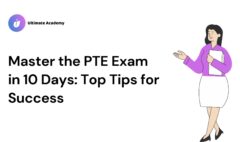How To Summarise Written Text For 79+ Score In PTE
Summarise Written Text is the first task in the PTE Writing section.
In this blog post, I am going to teach you everything you need to write a 79+ response to Summarise Written Text in PTE Writing.
Section 1
-
- Overview of The Summarise Written Text
Section 2
-
- Strategy To Solve It Using 2-3-4-1 Rule
Section 3
-
- Example of Solving A Real PTE Question
Section 1: Overview of The Summarise Written Text
Overview:
- You are given a text of about 300 words.
- Your task is to read and summarise it into a single sentence of a maximum of 75 words.
- The text could be on any topic. You don’t have to worry about that because you don’t have to be an expert at whatever the text you receive. All you need to know to do the task will be given in the text.
- Your time limit will be 10 minutes.
Scoring Criteria:
- Content
- Length/Form
- Grammar
- Vocabulary
To get the best score for Summarise Written Text in your PTE, you need to understand the above-mentioned categories thoroughly.
Let me break them down to you, simple and easy, one-by-one.
Content:
You are supposed to squeeze the main idea of the text into a single sentence.
You do this by understanding the meaning of the text, and paraphrasing it in your own words.
You do not need to use complex vocabulary or grammar that you are not comfortable with. A simple and clear response will get you full marks.
Do not add on too many details, rather make it as direct as possible.
That being said, there is one very important thing that many people make a mistake in. When a topic is given, they tend to add additional information, which is not mentioned in the given text.
That is an unnecessary act and that would most certainly lead you to score a 0 for your content.
Do not include your ideas.
All you need to know to do this task is already mentioned in the text, so you do not have to give any additional information regarding the text, even if you are an expert at the topic given.
The PTE exam tests your language and not your knowledge in a particular field. So make sure that your professional expertise does not cost you your chance at acing this exam.
Length/Form:
You are supposed to write a sentence using 5-75 words.
If you are given a word limit of 75 words, that does not mean you must use 75 words to form a sentence.
Usually, a sentence with 50-55 words will suffice.
So take no risk, make the sentence moderately long, but grammatically accurate – that is the key.
Grammar:
Try to write simple sentences if you are not comfortable in forming complex sentences, but make sure your grammar is on point.
Some quick things to keep in mind while writing:
- Use of capital letters at the beginning of the sentence.
- Use of proper conjunctions to make the sentence flow properly and easily.
- Capital letter for beginning the nouns.
- Use of comma wherever necessary.
- Full stop/period at the end of the sentence.
Vocabulary:
Use complex words only if you are aware of the meanings.
Otherwise, do not try to make an impression by using complex words with this thought in mind that the examiner (in this case, computer) is going to get impressed.
Remember, you gain fewer marks using high vocabulary words, but lose more marks if that word is wrong. So only use words that you are absolutely sure of.
Also, make sure your spellings are correct.
They play a vital role in the scoring criteria. If you know a word and its meaning, but you are not sure about its spelling, find a synonym for it.
Take no risks with words.
Now that you know what are the 4 criteria used to score PTE Summarise Written Text, let’s dive deeper into the strategy of solving these questions.
Section 2: Strategy To Solve It Using 2-3-4-1 Rule
At a glance, 10 minutes might seem too long of a time to summarise a text into a sentence, but trust me it isn’t.
You will need these 10 minutes to properly work on your task.
Do not rush to write your sentence and click ‘next’.
This won’t buy you more time for your next task. This 10-minute time limit is solely for the Summarise Written Text task, so make full use of it.
Abraham Lincoln once said, “If I had 6 hours to cut down a tree, I’d spend the first 4 hours sharpening the axe.”
This statement shows you how important planning is.
So, in order to do complete this task effectively, follow the 2-3-4-1 Rule.
The 2-3-4-1 Rule:
- In the first 2 minutes, comfortably read and analyse the text. Form a mental structure of the entire text.
- Use the next 3 minutes to write down 2-4 main points you think would summarise the given text most accurately.
- In the next 4 minutes, combine those points to write a grammatically sound sentence that summarises the text.
- The last 1 minute is the most vital. In this 1 minute, re-read your sentence to find mistakes. The mistake may be grammatical or a misspelling. This last-minute can result in the extra mark that you might be leaving on the table otherwise.
Let’s dig deeper into The 2-3-4-1 Rule:
First 2 minutes:
- Read the given text at least twice. But don’t read it in a rush. Instead, read with understanding.
- With the first read, you will have a rough idea about the topic.
- With the second read, you will pick the key phrases and ignore the details.
3 minutes:
- Once you have analysed the text, write down 2-4 key phrases from the text.
- Paraphrase them and write them down in your notebook or text area.
- Do not worry about combining them into one sentence yet. Instead, use this step to identify the key ideas of the text.
4 minutes:
- Now is the time when you combine those main ideas to make a single sentence.
- String them together as best as you can into one sentence using proper grammar and linking words. Your task is to write a sentence that can be read in a flow and combines all the key ideas you identified in the previous step.
- Do not rush. You have 4 minutes, and that is enough time to do the job.
Last 1 minute:
- The most important part of your task is rechecking.
- Many people, especially experts, go through their work once they are done writing, to make sure they haven’t made any mistake, and trust me when I say this, they always find some.
- Make sure your sentence has everything needed to sum up the given text.
- And recheck for your spellings and grammatical errors once more.
And finally, let’s apply the approach given above to a real example of a PTE Question.
Section 3: Example of Solving A Real PTE Question
Here is an actual text from the PTE exam for us to summarise.
Read the passage below and summarise it using one sentence. Type your response in the box at the bottom of the screen. You have 10 minutes to finish this task. Your response will be judged on the quality of your writing and on how well your response presents the key points in the passage.
The history of marketers seeking the advice of physicists is a short one, but an understanding of the theory of resonance may give communications experts the edge. Resonance theory explains the curious phenomenon of how very small pebbles dropped into a pond can create bigger waves than a large brick. The brick makes a decent splash but its ripples peter out quickly. A tiny pebble dropped into the same pond, followed by another, then another, then another, all timed carefully, will create ripples that build into small waves. As Dr. Carlo Contaldi, a physicist at Imperial College London, explains, a small amount of energy committed at just the right intervals – the ‘natural frequency’ – creates a cumulatively large effect. Media consultant Paul Bay believes that just as with pebbles in a pond, a carefully choreographed and meticulously timed stream of communication will have a more lasting effect than a sporadic big splash during prime time TV breaks.
So whether you’re trying to make waves in a laboratory or the media, the people in white coats would advise a little and often. A big budget is not a prerequisite of success.
I want you to first follow the pattern explained above to summarise this text on your own first before reading further.
After you’ve attempted, read on.
After reading it twice in the first 2 minutes and using the next 3 minutes, I have been able to extract these 3 key ideas out of the text:
- Marketers can learn from the Theory of Resonance in physics – small pebbles thrown at regular intervals create a bigger and longer lasting impact on waves in a pond than one brick thrown at once.
- Instead of prime time TV splash, marketers should design a constant stream of communication at the right intervals for a long-lasting effect.
- A big budget doesn’t always result in big success.
Notice here that I did not dig deeper into the names of the scientists or the repetitive words.
I stuck to the subject and took out the points that gave the text its real essence and meaning in just a few words.
I will now use the next 4 minutes to combine these 3 key ideas into one sentence.
You can either add conjunctions to do so, if the sentences are easily mergeable, or you can connect them by using a semi-colon to combine two sentences.
This is how my single-sentence response for Summarise Written Text looks like:
The principle of Theory of Resonance, which says that small pebbles thrown into a pond at regular intervals create a bigger impact than one big splash of brick, can be applied to marketing as well; wherein, instead of marketing through one big prime time TV splash, if marketers design a constant stream of communication at right intervals, the can achieve the long lasting effect without spending big budgets at marketing.
This is what my 90-scorer 70-words final response looks like using the 2-3-4-1 Rule.
In this blog post, I’ve explained what the PTE Summarise Written Text task is and how you can effectively solve it to get 79+ in your PTE Writing.
In my full course, Ultimate Guide to Acing PTE, of 67 video lessons of 12 hours, I go deep into the strategies, hacks, and techniques to help you learn all 4 sections of PTE in a smart way to get 79+ Score.
You can see all the details of the Ultimate Guide To Acing PTE below:







